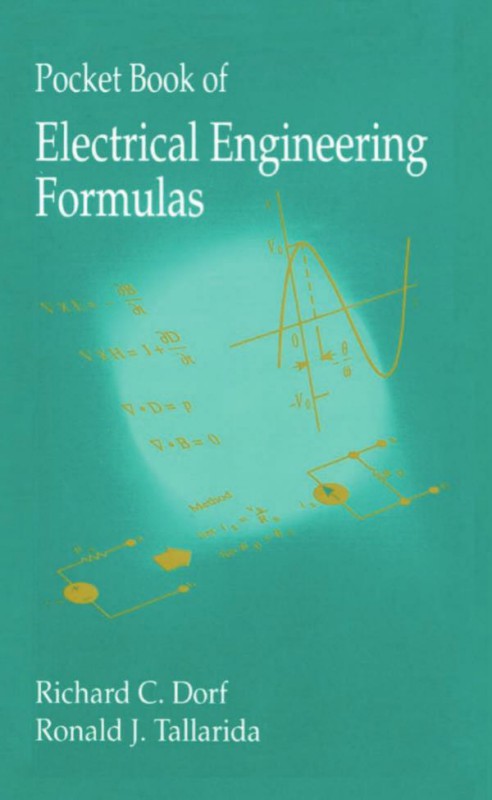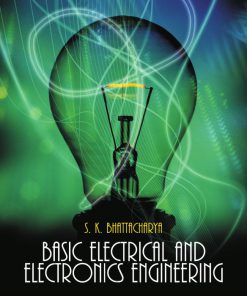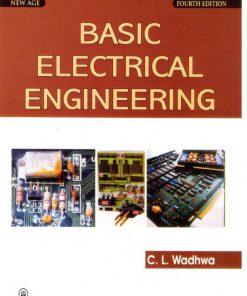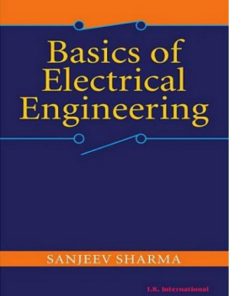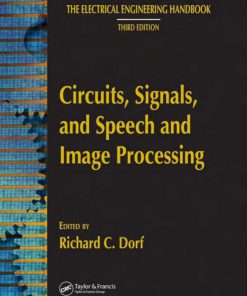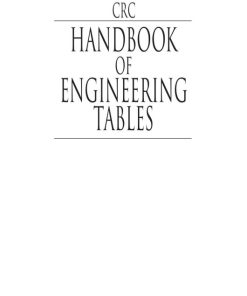(Ebook PDF) Pocket Book of Electrical Engineering Formulas 1st Edition by Richard Dorf, Ronald Tallarida 1351423975 9781351423977 full chapters
$50.00 Original price was: $50.00.$25.00Current price is: $25.00.
Authors:Richard C. Dorf , Series:Electrical Engineering [175] , Author sort:Dorf, Richard C. , Languages:Languages:eng , Published:Published:May 2017 , Publisher:CRC Press
Pocket Book of Electrical Engineering Formulas 1st Edition by Richard C. Dorf, Ronald J. Tallarida – Ebook PDF Instant Download/DeliveryISBN: 1351423975, 9781351423977
Full download Pocket Book of Electrical Engineering Formulas 1st Edition after payment.
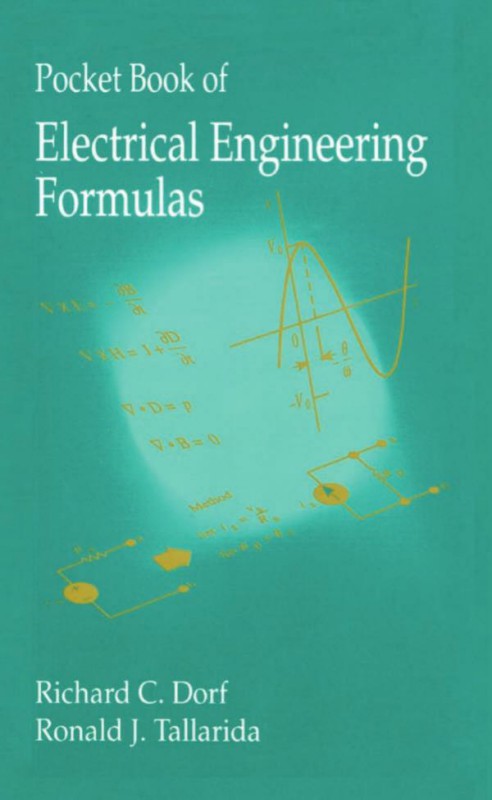
Product details:
ISBN-10 : 1351423975
ISBN-13 : 9781351423977
Author : Richard C. Dorf, Ronald J. Tallarida
Pocket Book of Electrical Engineering Formulas provides key formulas used in practically all areas of electrical engineering and applied mathematics. This handy, pocket-sized guide has been organized by topic field to make finding information quick and easy. The book features an extensive index and is an excellent quick reference for electrical engineers, educators, and students.
Pocket Book of Electrical Engineering Formulas 1st Table of contents:
1 Elementary Algebra and Geometry
1. Fundamental Properties (Real Numbers)
2. Exponents
3. Fractional Exponents
4. Irrational Exponents
5. Logarithms
6. Factorials
7. Binomial Theorem
8. Factors and Expansion
9. Progressions
10. Complex Numbers
11. Polar Form
12. Permutations
13. Combinations
14. Algebraic Equations
15. Geometry
2 Determinants, Matrices, and Linear Systems of Equations
1. Determinants
2. Evaluation by Cofactors
3. Properties of Determinants
4. Matrices
5. Operations
6. Properties
7. Transpose
8. Identity Matrix
9. Adjoint
10. Inverse Matrix
11. Systems of Linear Equations
12. Matrix Solution
3 Trigonometry
1. Triangles
2. Trigonometric Functions of an Angle
3. Trigonometric Identities
4. Inverse Trigonometric Functions
4 Analytic Geometry
1. Rectangular Coordinates
2. Distance between Two Points; Slope
3. Equations of Straight Lines
4. Distance from a Point to a Line
5. Circle
6. Parabola
7. Ellipse
8. Hyperbola
9. Change of Axes
10. General Equation of Degree Two
11. Polar Coordinates (Figure 4.16)
12. Curves and Equations
5 Series
1. Bernoulli and Euler Numbers
2. Series of Functions
3. Error Function
6 Differential Calculus
1. Notation
2. Slope of a Curve
3. Angle of Intersection of Two Curves
4. Radius of Curvature
5. Relative Maxima and Minima
6. Points of Inflection of a Curve
7. Taylor’s Formula
8. Indeterminant Forms
9. Numerical Methods
10. Functions of Two Variables
11. Partial Derivatives
7 Integral Calculus
1. Indefinite Integral
2. Definite Integral
3. Properties
4. Common Applications of the Definite Integral
5. Cylindrical and Spherical Coordinates
6. Double Integration
7. Surface Area and Volume by Double Integration
8. Centroid
8 Vector Analysis
1. Vectors
2. Vector Differentiation
3. Divergence Theorem
4. Stokes’ Theorem
5. Planar Motion in Polar Coordinates
9 Special Functions
1. Hyperbolic Functions
2. Gamma Function (Generalized Factorial Function)
3. Laplace Transforms
4. z-Transform
5. Fourier Series
6. Functions with Period Other than 2π
7. Bessel Functions
8. Legendre Polynomials
9. Laguerre Polynomials
10. Hermite Polynomials
11. Orthogonality
10 Differential Equations
1. First Order-First Degree Equations
2. Second Order Linear Equations (with Constant Coefficients)
11 Statistics
1. Arithmetic Mean
2. Median
3. Mode
4. Geometric Mean
5. Harmonic Mean
6. Variance
7. Standard Deviation
8. Coefficient of Variation
9. Probability
10. Binomial Distribution
11. Mean of Binomially Distributed Variable
12. Normal Distribution
13. Poisson Distribition
14. Least Squares Regression
15. Summary of Probability Distributions
12 Table of Derivatives
13 Table of Integrals
14 Resistor Circuits
1. Electric Current and Voltage
2. Current Flow in a Circuit Element
3. Resistance and Ohm’s Law
4. Kirchhoff’s Laws
5. Voltage and Current Divider Circuits
6. Equivalent Resistance and Equivalent Conductance
7. Node Voltages
8. Mesh Current Analysis
9. Source Transformations
10. The Superposition Principle
11. Thévenin’s Theorem
12. Norton’s Theorem
13. Tellegan’s Theorem
14. Maximum Power Transfer
15. Efficiency of Power Transfer
15 Circuits with Energy Storage Elements
1. Capacitors
2. Inductors
3. Energy Stored in Inductors and Capacitors
4. Series and Parallel Inductors
5. Series and Parallel Capacitors
6. The Natural Response of an RL or RC Circuit
7. The Forced Response of an RL or RC Circuit Excited by a Constant Source
8. The Natural Response of a RLC Circuit
16 AC Circuits
1. Phasor Voltage and Current
2. Kirchhoff’s Laws in Phasor Form
3. AC Steady-State Power
4. Maximum Power Transfer
5. Effective Value of a Sinusoidal Waveform
6. Power Delivered to an Impedance Z
7. Three-Phase Power
8. Power Calculations
9. The Reciprocity Theorem
10. Model of the Transformer
11. The Ideal Transformer
17 T and Π and Two-Port Networks
1. T and Π Networks
2. Two-Port Networks
18 Operational Amplifier Circuits
19 Electric Signals
20 Feedback Systems
21 Frequency Response
1. Bode Plots
2. Resonant Circuits
22 System Response
1. The Convolution Theorem
2. The Impulse Function
3. Impulse Response
4. Stability
23 Fourier Series
24 Fourier Transform
25 Paresval’s Theorem
26 Static Electric Fields
1. Unit Vectors and Coordinate Systems
2. Coulomb’s Law
3. Gauss’ Law
4. Maxwell’s Equation (Electrostatics)
5. Poisson’s Equation
6. Current Density
27 Static Magnetic Fields
1. Biot–Savart Law
2. Ampere’s Law
3. Maxwell’s Equations for Static Fields
4. Stokes’ Theorem
5. Magnetic Flux Density
28 Maxwell’s Equations
1. Maxwell’s Equations for Static Fields
2. Maxwell’s Equations for Time-Varying Fields
29 Semiconductors
1. Current in a Semiconductor
2. Semiconductor Diodes
3. Field Effect Transistors
4. Bipolar Junction Transistors (BJT)
30 Digital Logic
1. AND Gate
2. OR Gate
3. NOT Gate
4. NAND Gate
5. Exclusive-OR Gate
6. DeMorgan’s Theorems
31 Communication Systems
1. Half-Power Bandwidth
2. The Sampling Theorem
3. Amplitude Modulation
4. Phase and Frequency Modulation
5. A Measure of Information
6. Average Information (Entropy)
7. Channel Capacity (Shannon’s Theorem)
People also search for Pocket Book of Electrical Engineering Formulas 1st:
dp kothari basic electrical engineering pdf
dp kothari basic electrical engineering
bl theraja basic electrical engineering
ac circuits basic electrical engineering
dc circuits basic electrical engineering
You may also like…
eBook PDF
(Ebook PDF) Basic Electrical Engineering 1st edition by Bhattacharya 978-8131754566 full chapters
eBook PDF
(Ebook PDF) Basic Electrical Engineering 4th edition by Wadhwa 9788122429473 full chapters
eBook PDF
CRC Handbook of Engineering Tables 1st edition by Richard Dorf ISBN 0849315875 978-0849315879
eBook MOBI
(Ebook PDF) Electrical Engineering Experiments 1st edition by Chhalotra 9781683921158 full chapters

